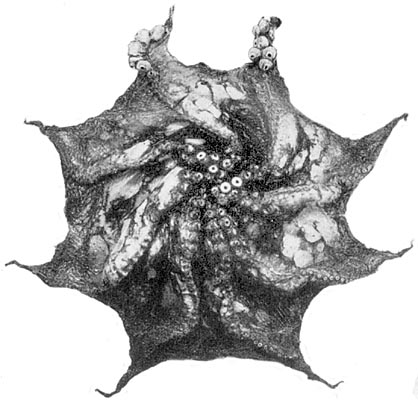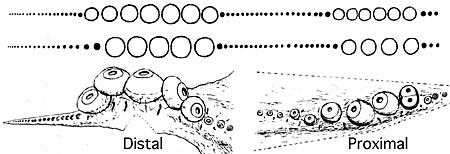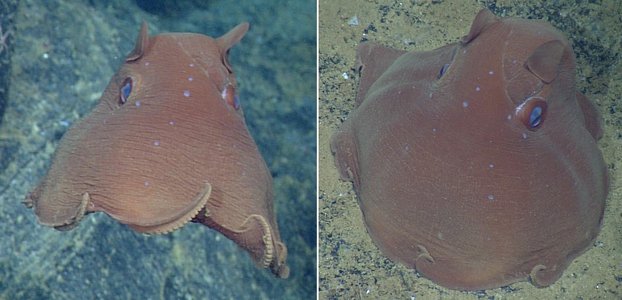Opisthoteuthis californiana
Richard E. Young and Michael VecchioneCharacteristics
- Arms and suckers
- Suckers enlarged in males in two fields;
- Sucker arrangement, arms II-IV (male): 1 small; 1 intermediate; 8-10 greatly enlarged; 5 (arms II) or 14 (arms III) or 12 (arms IV) much smaller; 20-30 minute.
- Sucker arrangement, arms I (male):1-2 minute; 1 intermediate; 8 greatly enlarged; 1 intermediate; 11-13 small; 1 intermediate; 6 greatly enlarged; 10-12 tiny.
 Click on an image to view larger version & data in a new window
Click on an image to view larger version & data in a new window
Figure. Oral view of O. californiana, male, 70 mm ML, Japanese waters. Photograph from Taki (1963).
- Head
- Beaks: Descriptions can be found here: Lower beak; upper beak.
- Beaks: Descriptions can be found here: Lower beak; upper beak.
The male specimens examined by Taki (1963) (see drawings below) had the following characteristics:
- Proximal field with suckers 4-11 enlarged (about 5-7 times those of the female); suckers 6 or 7 usually largest; all arms with equal enlargement.
- Distal field with 4-7 suckers enlarged, that correspond to sucker numbers 24-32; only arms I have a distal field.


Figure. Diagramatic arrangement of suckers of O. californiana, arms I (left - top; right - lower) and drawings of the proximal and distal portions of right arm I, note abnormal sucker near arm base. Drawings from Taki, 1963.
Comments
The above description is taken from Berry (1955) with the addition of a photograph and drawings from Taki (1963) of animals taken off Japan. More details of the description of O. californiana can be found here.
O. californiana and O. albatrossi are distinctive among species of Opisthoteuthis in having greatly enlarged suckers in the distal field only on arms I. The holotype of O. albatrossi is a young male and the proximal field may not have developed. These two species could be synonyms (Hochberg, pers. comm.)
Distribution
Type locality: Off Eureka Bar, California, 350 m. Also known from Japan, off Kashima-Nada, 530-560 m. Nesis (1982/87) reports it from the Bering Sea to the Sea of Okhotsk to off central Honshu in the northwestern Pacific and to off southern California in the northeastern Pacific.
References
Berry, S. S. 1949. A new Opisthoteuthis from the eastern Pacific. Leaflets in Malacology, 1 (6): 23-26.
Berry, S. S. 1952. The flapjack devil fish, Opisthoteuthis, in California. Calif. Fish and Game, 38: 183-188.
Berry, S. S. 1955. The male flapjack devilfish. California. Calif. Fish and Game, 41: 219-224.
Taki, I. 1963. On four newly known species of Octopoda from Japan. J. Fac. Fish. Anim. Husb., Hiroshima Univ., 5: 57-93.
Title Illustrations

| Scientific Name | Presumably O. californiana |
|---|---|
| Location | Northeast Pacific at 45.0°N, 130.0°W. 1551 m depth. |
| Comments | Image courtesy of the Monterey Bay Aquarium Research Institute (MBARI). You must obtain permission from MBARI to use this photo; please contact pressroom@mbari.org for further information |
| Acknowledgements | Susan Von Thun, photo editing, MBARI |
| Specimen Condition | Live Specimen |
| View | Side |
| Copyright | © 2011 MBARI |
About This Page

University of Hawaii, Honolulu, HI, USA

National Museum of Natural History, Washington, D. C. , USA
Page copyright © 2016 and
 Page: Tree of Life
Opisthoteuthis californiana .
Authored by
Richard E. Young and Michael Vecchione.
The TEXT of this page is licensed under the
Creative Commons Attribution-NonCommercial License - Version 3.0. Note that images and other media
featured on this page are each governed by their own license, and they may or may not be available
for reuse. Click on an image or a media link to access the media data window, which provides the
relevant licensing information. For the general terms and conditions of ToL material reuse and
redistribution, please see the Tree of Life Copyright
Policies.
Page: Tree of Life
Opisthoteuthis californiana .
Authored by
Richard E. Young and Michael Vecchione.
The TEXT of this page is licensed under the
Creative Commons Attribution-NonCommercial License - Version 3.0. Note that images and other media
featured on this page are each governed by their own license, and they may or may not be available
for reuse. Click on an image or a media link to access the media data window, which provides the
relevant licensing information. For the general terms and conditions of ToL material reuse and
redistribution, please see the Tree of Life Copyright
Policies.
- First online 13 May 2003
Citing this page:
Young, Richard E. and Michael Vecchione. 2003. Opisthoteuthis californiana . Version 13 May 2003 (under construction). http://tolweb.org/Opisthoteuthis_californiana/20155/2003.05.13 in The Tree of Life Web Project, http://tolweb.org/








 Go to quick links
Go to quick search
Go to navigation for this section of the ToL site
Go to detailed links for the ToL site
Go to quick links
Go to quick search
Go to navigation for this section of the ToL site
Go to detailed links for the ToL site